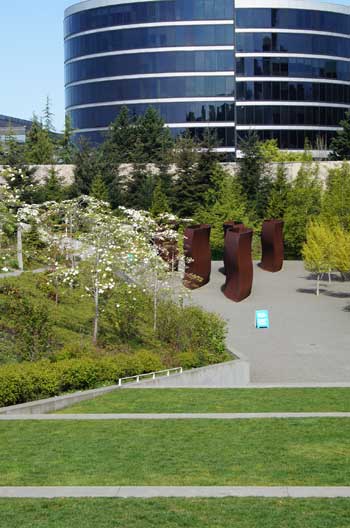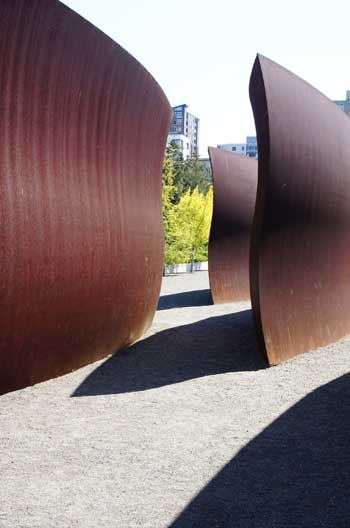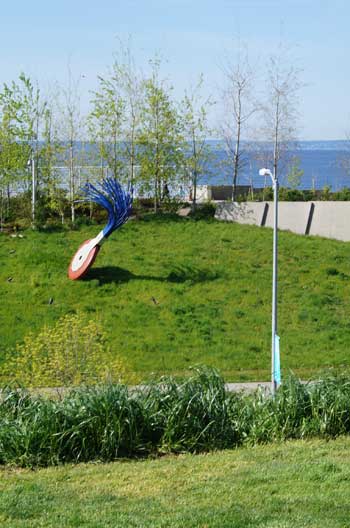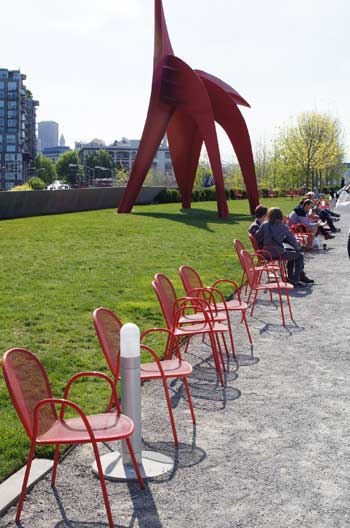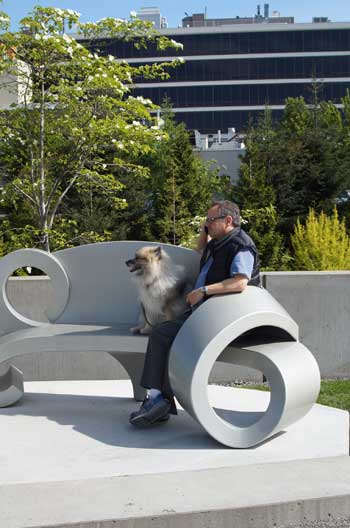How Seattle Balances Nature and the Built Infrastructure (Part 2)
Seattle has long been an innovator in layering built and natural infrastructure so the two more fully complement each other. Over the past few decades, the city has taken advantage of all that rain so ever-present greenery seems to equal — if not dominate — the roads, bridges, and buildings. While locals may want even more parks, for someone just visiting the city the first time, Seattle exclaims Pacific Northwest first and then city. Perhaps it's the dramatic mountains, with their views carefully preserved from so many places in the city, or the water that is never far away. Or how trees and plants seem to be found everywhere they possibly can be. In the second in a series of posts on how Seattle has integrated built and natural infrastructure, we look at the Seattle Art Museum Olympic Sculpture Park by interdisciplinary design firm Weiss/Manfredi, with Charles Anderson Landscape Architecture, in downtown.
Here is an example of how an incredibly difficult site with hardcore infrastructure needs — it must accommodate a railroad line, four-lane street, riverfront bike lane, and sea wall — was made a true destination with the addition of an inviting green public space that is a showcase for both art and the natural splendor of Seattle.
According to Julie Parrett, ASLA, a landscape architect who worked with Charles Anderson Landscape Architecture during the project and gave a tour of it for the American Planning Association (APA) conference, the site where the Seattle Art Museum built their park was owned by Union Oil Company of California up until 1999.
When the museum was looking to expand their existing facility, developers were on their way to grabbing the property to turn into more apartments. At the 11th hour, $1 million was raised by Jon Shirley, a benefactor made wealthy by his role in Microsoft, and his wife Mary, to secure the land for a new sculpture park. They also created a $25 million operations and maintenance fund for the park in the beginning, so it would be "private but for public use."
Still, it took nearly 10 years and much expense for this widely popular destination and neighborhood park to happen. The 8.5 acres of land were purchased for $20 million. Given the site was once a depot for train cars carrying oil, the clean up of the toxic soils cost another $5 million. For such a challenging site, the design and construction totaled $40 million.
The park's M-shaped-path smartly invites exploration but also hides some of the limitations of the space. Upon first visiting, you are conveyed down to a striking rusted steel art work by Richard Serra, accessible via grassy stair-step terraces or a meandering trail — or drawn down across the first diagonal of the M to the grand vista of the bay and mountains. Those terraces double as an amphitheater for cultural events, with the Serra piece serving as a backdrop.
As you cross the first diagonal of the M, you begin to notice a slight change in elevation crossing over the four-lane street below. Again, it's amazing how the views, landscape, and art together conspire to distract your eye from the transportation infrastructure below. Perhaps the experience would be different if the street was packed with cars. The time of day we visited, there were hardly any.
As you continue across the other diagonal of the M, you come across seating arranged for viewing the spectacular scenery.
Then, as you progress down over the rail line towards the waterfront, the experience changes again. Blasted with salty air, you make your way across the bike lanes to the railings facing the Elliott Bay and the 350-foot-long revamped sea wall that doubles as specially-constructed juvenile salmon habitat. Plants there were designed to accommodate for sea water inundation but otherwise Parrett said the site was not "designed for rising tides."
The Seattle Art Museum is not kidding about maintenance. There was literally no trash to be found anywhere. The waterfront was free of any refuse, except for driftwood that is allowed to naturally accumulate in the built inlet that is then removed annually. At the constructed beach, Parrett explained that the riprap had been set there before, but the underwater slope was orchestrated so that "it would maintain itself."
For Parrett, the fact that there is a open beach and wildlife habitat in the sculpture park is worth highlighting. "This is a museum that took on an ecological agenda."
She explained the great obstacles the design and construction team faced in realizing the park:
First, the team learned the 350-feet-long sea wall had to be replaced or repaired. The museum found that fully replacing the wall, which has to hold back tidal changes of 13 feet each day, could easily cost $50-80 million. "Paying this amount would have shut down the project," so instead, the team looked to stabilize the wall while creating habitat for juvenile salmon. Salmon, which you hear about with regular frequency in Seattle, are endangered, but much effort is made to ensure they too benefit from the infrastructure primarily made for people. As Seattle city government senior planner Patrice Carol, the APA tour organizer, explained, "when we are doing anything in Seattle that impacts the water, we are dealing with the Endangered Species Act."
The design team used in fill-in ballast to create a nooks and crannies — a "habitat bench" — that small salmon can swim into without getting picked off by predators. Salmon come out of the Puget Sound and return to the freshwater lakes and streams were they were born to spawn. Young salmon then go back the way their progenitors came.
As Parrett, explained, "the bench has been hugely successful and has become a demonstration project." It also just cost $5.5 million for the new sea wall and habitat combination, and because it involved salmon, the team was able to leverage federal funds.
Second, the site is a brownfield. Given its past history as part of Union Oil's operations, 117,000 tons of contaminated soils had to be removed. And 300,000 cubic yards of new soil was brought in, much of it from 8 blocks away where there was a development. Still, with the underlying toxic asphalt, the designers could only dig down 3 feet in areas. Art, particularly the heavy pieces, had to be carefully placed to ensure they didn't spark leakages. "There is still ongoing monitoring."
Third, the development of the park required removing the last of Seattle's beloved waterfront streetcar infrastructure. As Parrett explained, "this almost derailed the project." The streetcar line has been replaced by a two-way bicycle track that was heavily used the day we were out.
Lastly, cleaning all stormwater runoff heading down the slope into the bay meant designing wetlands to store water from the site in key spots and slowly release it, which attracts the bugs salmon like to eat. The site was designed to feature almost an entirely native plant palette, "with every tree and plant hand selected," so no pesticides would be needed. But the primary challenge turns out to be controlling "runoff" from dogs doing their business on the lawns, no matter how cute they may be.
Parrett explained how there are security guards always present to ward off dog owners that don't obey signs, and the museum periodically rope off parts of the landscape to let it recover. "But we must use fish compost to keep the lawns alive."


